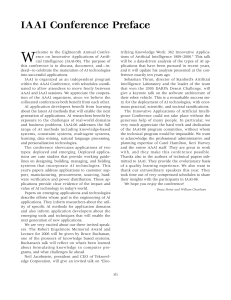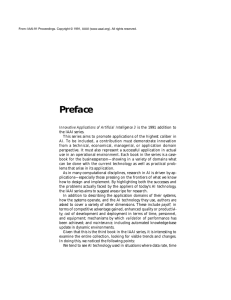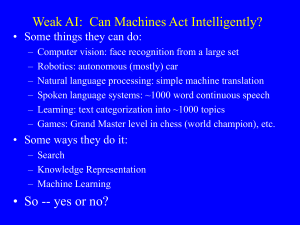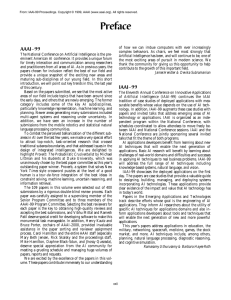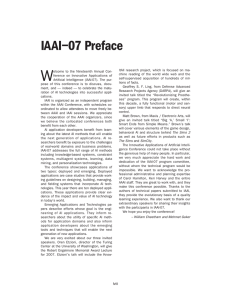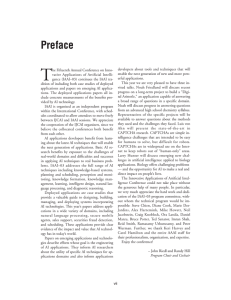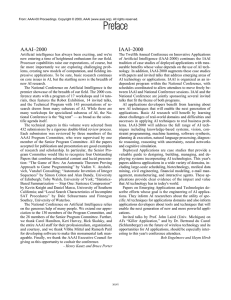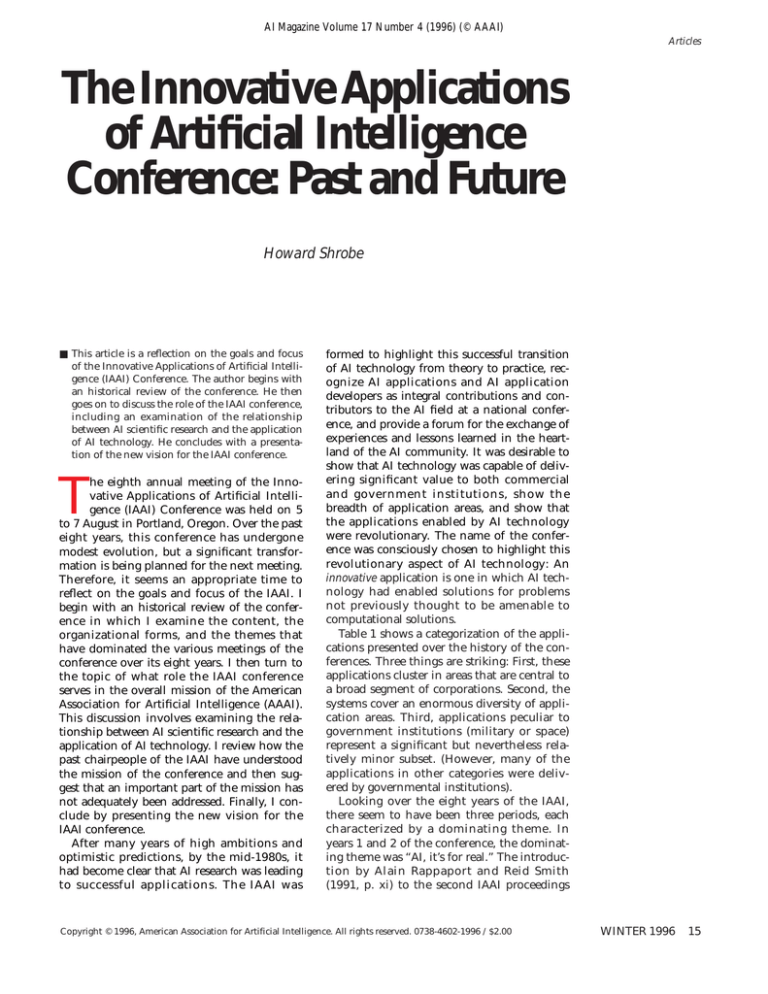
AI Magazine Volume 17 Number 4 (1996) (© AAAI)
Articles
The Innovative Applications
of Artificial Intelligence
Conference: Past and Future
Howard Shrobe
■ This article is a reflection on the goals and focus
of the Innovative Applications of Artificial Intelligence (IAAI) Conference. The author begins with
an historical review of the conference. He then
goes on to discuss the role of the IAAI conference,
including an examination of the relationship
between AI scientific research and the application
of AI technology. He concludes with a presentation of the new vision for the IAAI conference.
T
he eighth annual meeting of the Innovative Applications of Artificial Intelligence (IAAI) Conference was held on 5
to 7 August in Portland, Oregon. Over the past
eight years, this conference has undergone
modest evolution, but a significant transformation is being planned for the next meeting.
Therefore, it seems an appropriate time to
reflect on the goals and focus of the IAAI. I
begin with an historical review of the conference in which I examine the content, the
organizational forms, and the themes that
have dominated the various meetings of the
conference over its eight years. I then turn to
the topic of what role the IAAI conference
serves in the overall mission of the American
Association for Artificial Intelligence (AAAI).
This discussion involves examining the relationship between AI scientific research and the
application of AI technology. I review how the
past chairpeople of the IAAI have understood
the mission of the conference and then suggest that an important part of the mission has
not adequately been addressed. Finally, I conclude by presenting the new vision for the
IAAI conference.
After many years of high ambitions and
optimistic predictions, by the mid-1980s, it
had become clear that AI research was leading
to successful applications. The IAAI was
formed to highlight this successful transition
of AI technology from theory to practice, recognize AI applications and AI application
developers as integral contributions and contributors to the AI field at a national conference, and provide a forum for the exchange of
experiences and lessons learned in the heartland of the AI community. It was desirable to
show that AI technology was capable of delivering significant value to both commercial
and government institutions, show the
breadth of application areas, and show that
the applications enabled by AI technology
were revolutionary. The name of the conference was consciously chosen to highlight this
revolutionary aspect of AI technology: An
innovative application is one in which AI technology had enabled solutions for problems
not previously thought to be amenable to
computational solutions.
Table 1 shows a categorization of the applications presented over the history of the conferences. Three things are striking: First, these
applications cluster in areas that are central to
a broad segment of corporations. Second, the
systems cover an enormous diversity of application areas. Third, applications peculiar to
government institutions (military or space)
represent a significant but nevertheless relatively minor subset. (However, many of the
applications in other categories were delivered by governmental institutions).
Looking over the eight years of the IAAI,
there seem to have been three periods, each
characterized by a dominating theme. In
years 1 and 2 of the conference, the dominating theme was “AI, it’s for real.” The introduction by Alain Rappaport and Reid Smith
(1991, p. xi) to the second IAAI proceedings
Copyright © 1996, American Association for Artificial Intelligence. All rights reserved. 0738-4602-1996 / $2.00
WINTER 1996
15
Articles
Table 1. A Categorization of the Applications
Presented over the History of the IAAI Conferences.
Manufacturing and design
Business operations
Finance
Telephony
Diagnostics and troubleshooting
Claims processing and auditing
Information retrieval and classification
Computers and software engineering
Military
Space
30
26
25
12
11
10
9
8
6
4
highlights this theme:
While academic research continues to
progress, deployed applications
demonstrate the utility of this new
computer technology. Applications have
become a driving force in bringing AI
into the mainstream, well integrated
with existing computing environments
(emphasis mine).
Certainly, part of this theme was illustrated
by the deployment of elephant applications,
those that were large scale and produced dramatic payback in both relative and absolute
terms. Among these were applications from
such large organizations as IBM, AMEX, Digital Equipment, Chase Bank, and the United
States Navy. The applications were not limited
to the United States; several came from Japan,
Singapore, and Korea. Not all the applications
were elephants; there were many rabbits,
small-scale applications of AI, built quickly
and nimbly, with modest investment and significant relative (but not necessarily large
absolute) payback. Dupont, in particular,
championed the strategy of building many
rabbits rather than a single large elephant.
The greatest impediment to getting these
applications built was the difficulty of integrating the AI component of the application
with the conventional flow of business data
processing. It was this integration task that
became the dominating theme for the next
several years (years 3–6 roughly). As program
chairs Reid Smith and Carlisle Scott (1992)
noted in the introduction to the proceedings
of IAAI 3,
On a discouraging note, application
developers continue to be forced to
spend large fractions of their time cop-
16
AI MAGAZINE
ing with unfortunate and grim realities of integrated computing in today’s
world…. For too much talent is dissipated in piecing together, rewriting or
force fitting low-level components not
designed for evolution (emphasis mine).
What caused the problem was a mismatch
between the platforms that were used to
develop AI applications and the platforms
that supported mainstream business data processing. The AI components were typically
built to run on UNIX workstations (and Lisp
Machines in the earlier days) that were comfortable in a distributed, internetworking
environment. In contrast, the corporate
mainframe environment was more proprietary, provided inelegant communications
and weak support for distributed processing,
but it owned the data. The usual approach to
integration was to make the workstation pretend to be a 3270 dumb terminal; it would
receive the same textual forms that the conventional application developers had intended for a human operator and then extract the
information useful for the AI application
from these textual forms, a technique know
as screen scraping.
Because AI was a leading-edge technology,
it arrived in this world too early. As a consequence, the AI application community had to
ride many waves of technological quick fixes
and fads. Over the years, the focus moved
from corporate mainframes with their Cobol
and PL/1 orientation to PCs, C, and C++; proprietary client-server frameworks dominated
for a while. Unfortunately, keeping up with
these changes seemed to occupy more of the
application developers’ time than keeping up
with new research results from the AI
research community.
Many of these integration problems are
now being addressed head on by a broad community of information technologists using
Internet-based frameworks such as CORBA and
the World Wide Web. Ironically, the network
orientation of the early workstation-based systems (which earlier seemed like an impediment) is exactly what everybody is now
scrambling to regain. I do not mean to argue
that the integration problem was unimportant; clearly, it was critical. However, it is a
transient and ever-changing problem. It
would be an exciting prospect to see AI technology applied to this integration problem, so
that what is now a painful and low-level–system programming task might, in the future,
be reduced to the much simpler task of
describing the characteristics of the systems
that need to be integrated. I look forward to
Articles
seeing such intelligent integration technology
reported on in future IAAI conferences.
In the last couple of years, as tools for integrating with enterprise-scale computing have
become more common in the mainstream,
and the technology for building AI systems
has become relatively routine and mature,
the focus of the IAAI meetings has again
shifted. Now, the case studies in the conference focus primarily on the domain and task
analysis and on the appropriate matching of
the problem characteristics to available technological solutions. I find this a refreshing
trend and hope that it truly characterizes the
spirit of upcoming IAAIs.
The organizational form of the IAAI conferences mirrored to some extent these themes.
The first two conferences were held in separate locations and different times from the
national conference on AI to call special
attention to the exciting new applications.
Over the next several years, the IAAI conference was moved into greater alignment with
the national conference. First, the two conferences were colocated but maintained separate
registrations, proceedings, and reviewing
policies; in later years, certain sessions were
shared between the conferences, but in general, the feeling was that the IAAI and the
national conference should maintain separate
identities. Because the dominating issue for
IAAI papers was often integration with mainstream computing, there was limited opportunity for interaction with the AI research
community.
As the focus of the IAAI has returned in the
last couple of years to domain and problem
analysis, it has seemed increasingly relevant
to integrate the IAAI more completely with
the AAAI conference. In 1996, we moved to a
single registration fee and a single proceedings, including the papers from both conferences. Next year, as the call for papers makes
clear, we move even further in this process of
integrating the two conferences.
Given that the IAAI and AAAI conferences
are moving closer both intellectually and
organizationally, it seems appropriate to turn
now to a discussion of what the nature of AI
research is and how it relates to the practice
of building applications of AI technology.
As a scientific discipline, AI has always been
a bit unusual. According to at least one
definition, AI is the study of machine intelligence. Under this definition, AI is quite unlike
the natural sciences, which study existing
phenomena; AI studies the (largely) nonexistent phenomenon of machine intelligence
and seeks to bring it into existence. AI has
always, therefore, been both speculative and
constructive: We don’t necessarily know what
a machine intelligence would look like, so we
try to build one, perhaps learning more from
our mistakes than from our successes. This
experimental approach to AI science is hard to
distinguish from the more pragmatic engineering attempt to build useful programs that
exhibit some degree of intelligent processing.
Of course, AI is not just the attempt to
understand machine intelligence; for many, it
is equally concerned with understanding
human intelligence, either as an end in itself
or because human intelligence provides the
most useful model of intelligent behavior
that we can find. In this view of AI science,
we build programs as experimental models of
human cognition. In building such models,
we often find ourselves asking what it is in
the way people think about a certain problem
that allows them to effectively cope with it.
Again, these scientific pursuits are hard to
separate from the similar engineering pursuits
of building programs that do useful tasks by
emulating human cognition. In the scientific
pursuit, we ask how people look at a task in
As the focus of the IAAI has returned in
the last couple of years to domain and
problem analysis, it has seemed increasingly
relevant to integrate the IAAI more
completely with the AAAI conference.
WINTER 1996 17
Articles
IAAI Articles in This Issue
T
his issue of AI Magazine includes five case studies that were
presented at the Eighth Innovative Applications of Artificial
Intelligence on 5 to 7 August 1996 in Portland, Oregon.
“Diagnosing Delivery Problems in the White House InformationDistribution System” by Mark Nahabedian and myself describes an
AI component of a much larger system that the AI Lab at the Massachusetts Institute of Technology has built for use by the White
House Office of Media Affairs. When the Clinton administration
took office, it decided to utilize the rapidly growing National Information Infrastructure to bring information directly to the average
citizen. Speeches, press releases, and the transcripts of press
briefings are all made available daily to anybody interested through
both the World Wide Web and e-mail. The e-mail channel allows
users to create a profile specifying the type of information that
interests them; as documents are released, they are e-mailed to all
those whose profiles indicate an interest. This system has been estimated to reach more than 100,000 recipients. Unfortunately, the
Internet is a relatively volatile and anarchic environment: E-mail
addresses become invalid frequently as users move from one site to
another. The bounced mail expert system (BMES) described in this
article diagnoses such failures to get e-mail delivered and helps the
administrator remove obsolete mail addresses. The system has
reduced the portion of the system administrator’s daily work load
consumed by the management of bounced e-mail from 3 hours to
30 minutes.
“Intelligent Retail Logistics Scheduling” by John Rowe, Keith
Jewers, Joe Sivayogan, Andrew Codd, and Andrew Alcock describes
a scheduling system developed by J. Sainsbury, one of England’s
largest retailers (with 11.7 percent of the market and 12 billion
British pounds of annual business). The supply-chain integrated
ordering network (SCION) described in this case study has allowed
Sainsbury to dramatically increase the efficiency of its depots and
distribution network for nonperishable goods. The system manages
22 warehouses and processes between 100,000 and 200,000 pallets
of nonperishable commodities to be placed on 5,000 to 10,000
vehicles each order cycle. SCION is, in effect, a constraint-directed
scheduling system that determines, among other things, when
goods should be delivered and which vehicles should carry them.
SCION has allowed Sainsbury to move from weekly planning and
scheduling to daily; Sainsbury estimates that the system will return
its investment in 6 months and will lead to benefits of more than
10 million British pounds over the next 5 years.
“Using Artificial Neural Networks to Predict the Quality and Performance of Oil-Field Cements” by P. V. Coveney, T. L. Hughes, and
P. Fletcher describes an innovative use of neural network technology in oil-field operations. Schlumberger is one of the world’s largest
oil-field service companies, and it was also one of the first large
companies to explore the use of AI technology. Oil-field cements
are used to line oil and gas wells after drilling by pumping a slurry
between the well bore and a steel case inserted into the well. The
thickening time of the cement is critical: If the cement sets too
quickly, it can set in the pumping equipment or otherwise cause
catastrophic failure; if it sets too slowly, then it imposes an unnecessary delay until drilling can resume. Delays can cost more than $1
million a day. Unfortunately, the properties of cement are extremely difficult to predict. Schlumberger tackled this problem by using a
18
AI MAGAZINE
such a way that makes it computationally
tractable, and then we go on to ask what
abstractions, knowledge, problem-solving
methods, and computational machinery support this. In the engineering task, we ask how
people look at the task we’re interested in
automating, and then we go on to examine
what abstractions, knowledge, problem-solving methods, and computational machinery
might support it. We then go on to make
pragmatic decisions about both what we
know how to automate economically and
what is institutionally relevant to automate.
The science of AI and the engineering discipline of AI have much to learn from one
another, and it is this synergy that we hope
to further develop with the new format for
the IAAI. To date, we have seen one small
example of how the conference can facilitate
interchange between the scientific and engineering aspects of AI. Case-based reasoning
was a new problem-solving paradigm that
emerged from the research environment during the mid-years of the IAAI. It was one
picked up quickly by the application development community because of its relevance to
help desks and a large number of other applications. However, there is a significant gap
between the practical uses of case-based reasoning, which are limited almost totally to
case retrieval, and the full paradigm as it
emerged in the research community, which
involves not just retrieval but also case adaptation, debugging, and so on. The research
antecedents of this paradigm go far back in
the AI research literature to early work on
planning (STRIPS) and debugging (Sussman’s
H A C K E R ) as well as to the mor e obvious
antecedents in the work of Roger Schank and
his colleagues on scripts and other episodic
representations of knowledge.
Why didn’t this rich research tradition
show up in the applications? There are several explanations, not necessarily contradictory: First, in many application settings, case
adaptation is what people do, and they’re
good at it; retrieval is what machines do better. A second explanation is that the application areas pursued don’t require case adaptation. A third explanation is that the research
in this area isn’t yet ready for prime time, and
we need to better understand the paradigm,
particularly in the context of demanding
applications. The fact that this third explanation is at least plausible led to a AAAI fall
symposium on knowledge adaptation, perhaps with some useful outcomes.
How then did the organizers of the IAAI
conferences conceive of the goal of the con-
Articles
ference? We reviewed the program chairs’
introductions to the proceedings of the IAAI
conferences to get a sense of this. We found
the following comments in the introduction
to the first proceedings (Schorr and Rappaport 1990, p. vii); notice it’s emphasis on the
“it’s for real” theme:
The emergence of scientific achievements from the field of AI has triggered
opportunities to tackle new problems
in which the computer formerly had no
role…. If we have not achieved all the
goals of automating cognition yet, our
years of research are rewarded by what
we feel can have a major impact on
ever yday
operations
in
the
workplace… (emphasis mine).
Program chairs Reid Smith and Carlisle
Scott (1992, p. ix) take this theme even further in the third conference proceedings,
describing the conference as “a casebook for
the businessperson—showing in a variety of
domains what can be done with the current technology as well as practical problems that arise in its application” (emphasis
mine). I already noted previously that the
introduction to the third conference emphasized the integration problem (bemoaning its
“grim realities”), which dominated the conference for many years.
However, we also find in these introductions inspiring ideas about how the scientific
and engineering aspects of AI can relate to
one another. The first conference proceedings
(Schorr and Rappaport 1990, p. vii) notes that
“[s]uch a forum can further the exchange of
information on what really works and
what the problems are. Tackling these new
applications will lead to better technology
because we will find and remedy current
deficiencies when solving ‘real’ problems”
(emphasis mine). The introduction to the third
conference (Smith and Scott 1992, p. ix) suggests that the research community can find
its best challenges in the applications world:
“Research is driven by applications—especially those pressing on the frontiers of what
we know how to design and implement”
(emphasis mine).
What then should be the role of the IAAI?
Conference organizers believe that the correct
emphasis going forward is in the vision represented in these two quotations, that is, to
“further the exchange of information on
what really works and what the problems
are” (Schorr and Rappaport 1990) with the
hope that “tackling these new applications
will lead to better technology” (Schorr and
Rappaport 1990). AI research and the applica-
combination of powerful AI and signal-processing techniques:
They trained a neural network to use a Fourier transform infrared
spectogram of the cement to make accurate predictions of its properties. This combination of technologies has not only led to greater
accuracy, but it has also contributed to the understanding of
cement chemistry.
“COMET: An Application of Model-Based Reasoning to Accounting
Systems” by Robert Nado, Melanie Chams, Jeff Delisio, and Walter
Hamscher describes an advanced system being deployed at Price
Waterhouse, one of the world’s largest accounting firms. One of the
services that Price Waterhouse’s auditors provides its customers is
an analysis of the controls built into the customer’s accounting systems. Accounting controls attempt to guarantee that the data within the system are accurate and nonfraudulent. Accounting systems
consist of both automated and manual processes; in today’s world,
they are large, distributed information systems whose design is not
often available. Thus, one of the auditors’ most difficult tasks is to
construct a model of the accounting system that is accurate
enough to assess the efficacy of the controls within the system.
COMET provides both model-building and model-analysis support.
The construction tools help by providing a convenient, graphic,
and hierarchical framework for developing the models and consistency-checking tools to catch obvious errors. The analysis tools are
based on the observation that all actions in an accounting system
can be reduced to one of a few primitive action types and that each
of these is subject to only a few basic failure types. COMET can simulate these primitive failure types and then use the model to determine if these failures will be caught by controls within the
accounting system. To date, more than 20 percent of the Price
Waterhouse auditors have been trained in the use of COMET, and it
is rapidly becoming the recommended tool with Price Waterhouse
for the evaluation of complex customer systems.
“Developing and Deploying Knowledge on a Global Scale” by
James Borron, David Morales, and Philip Klahr describes REUTERS, a
global-scale help desk that uses case-based reasoning. REUTERS provides a broad variety of new, financial, and other information products in countries around the world, and it is an important component of the business that customers receive fast and effective service
when they have difficulty using these services. Reuters undertook to
tap the internal expertise of its worldwide organization to build a
collection of cases that could effectively provide this support. It built
a case base of more than 7700 cases, covering 38 different products
and services, that is installed in 29 sites around the world and is used
by 190 help-desk personnel who directly service Reuters’s customers.
The article describes how the company organized and managed the
case-acquisition process and tools it developed to help maintain consistency and completeness in the case base.
These five case studies illustrate the broad applicability and the
continued maturation of AI technology. AI plays a critical role in
the management of business practices, engineering, and even innovative attempts to better connect the U.S. government with its citizenry. These case studies also illustrate another key contribution of
AI technology: its ability to help organizations rapidly evolve to
meet new needs. This contribution is particularly clear in the
White House application: Four years ago, the White House didn’t
use e-mail, and the World Wide Web barely existed; today, AI technology helps it manage the complexity of the broad-scale use of
these technologies.
WINTER 1996 19
Articles
tion of this research should be related intimately. Our conferences should highlight
research that is reaching a level of maturity
appropriate for application, and they should
also examine the adequacy of our current
technology in the context of challenging,
innovative applications.
In addition, we would like to create a new
focus on emerging technology; technology to
us means the consolidation of scientific
insight in a form that allows routine application. This new focus will include domain
analyses, ontologies and core domain theories, paradigm-specific inference engines, and
collaborative knowledge-acquisition tools
appropriate for the construction of large-scale
knowledge bases. In general, this focus will
help us examine the insights gained in the
attempts to apply AI research and will help us
consolidate these insights into useful technology. With the 1996 conference, organizers
began the transition to this new view of the
IAAI conference. Most notably, we added a
series of invited talks that survey areas of AI
research that are beginning to emerge into
practice, including “AI in Aircraft Design” by
Robert Abarbanel from Boeing, “AI in Software Engineering” by Doug Smith of Kestrel
Institute, “Speech Technology” by George
Doddington of SRI International and the
National Security Agency, “Planning” by
Mark Boddy of Honeywell, “AI in Computational Biology” by Rick Lathrop of the University of California at Irvine, and “Knowledge Discovery and Data Mining” by Usama
Fayyad of Microsoft. These are areas in which
we expect to see significant new applications
of AI technology in upcoming IAAI conferences. In addition, the IAAI and the AAAI
conferences cosponsored an evaluative talk
by Frederick Hayes-Roth of Teknowledge entitled “AI, What Works and What Doesn’t?”
Organizationally, the IAAI and AAAI conferences are now merged; there is a single
proceedings and registration fee, and all sessions are open to all participants, although
there are separate calls for papers and different reviewing criteria. The 1997 conference
will move further in this direction. The
national AI and IAAI conferences will be distinct programs within the common annual
meeting of the AAAI. To supplement the
award-winning case studies of innovative,
deployed applications, IAAI will add a new
track of papers on emerging applications,
technology, and issues. The acceptance criteria are presented in detail in the call for
papers, but the general principle is that application case studies that can teach us some-
20
AI MAGAZINE
thing new about AI technology are the ones
that will be presented. Conference organizers
are continuing the Innovative Applications
Award for applications that meet the criteria
established in past IAAI conferences, that is,
those that meet the highest standards of
innovation, are fully deployed, and exhibit
substantial paybacks. We have added a nomination form to the call for papers in the hope
of finding a broader range of innovative
applications that qualify for the award, especially those that increase representation of
the full range of AI applications and research
areas. Other applications, which do not meet
all the deployment, innovation, and payback
criteria but which yield insight about the
application of AI technology, will be accepted
for the new emerging applications, technology, and issues track of IAAI.
We hope these changes further improve
the IAAI conference, broaden the range of
people who feel that the conference has
something valuable for them, and provide a
forum for issues that have found no forum in
either the IAAI or AAAI conferences of the
last several years. Finally, we ask for the help
of all AAAI members in bringing innovative
applications to our attention and submitting
invited talk nominations and panel proposals
to make IAAI serve the role of fostering a
mutually productive dialog between fundamental and applied AI.
References
Rappaport, A., and Smith, R., eds. 1991. Innovative
Applications of Artificial Intelligence 2. Menlo Park,
Calif.: AAAI Press.
Schorr, H., and Rappaport, A., eds. 1990. Innovative
Applications of Artificial Intelligence. Menlo Park,
Calif.: AAAI Press.
Smith, R., and Scott, C., eds. 1992. Innovative Applications of Artificial Intelligence 3. Menlo Park, Calif.:
AAAI Press.
Howard Shrobe is assistant director of Intelligent
Systems and Software Technology and chief scientist of the Defense Advanced Research Projects
Agency (DARPA) Information Technology Office.
He directs programs in the areas of software engineering, information survivability, and AI. Shrobe
is on loan to DARPA from the Massachusetts Institute of Technology (MIT), where he has been a
principle research scientist in the Artificial Intelligence Laboratory since 1979. From 1982 to 1992,
Shrobe split his time between MIT and Symbolics
Inc., where he served as a technical director and
vice-president of technology. Shrobe received his
M.S. (1975) and Ph.D. (1978) from the Artificial
Intelligence Laboratory at MIT, where he was a
cofounder of the Programmer’s Apprentice Project,
and his B.S. (1968) from Yale College.

